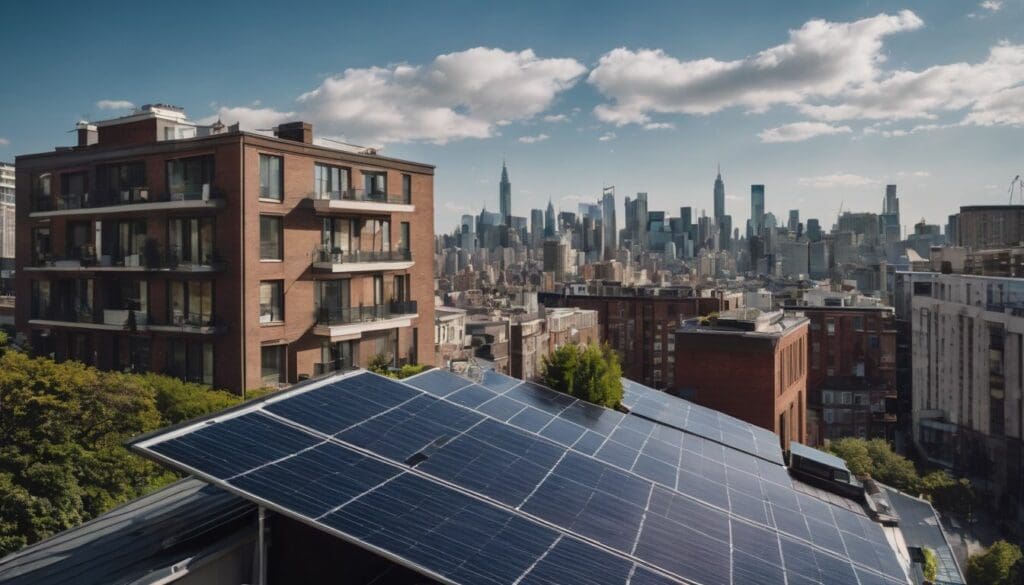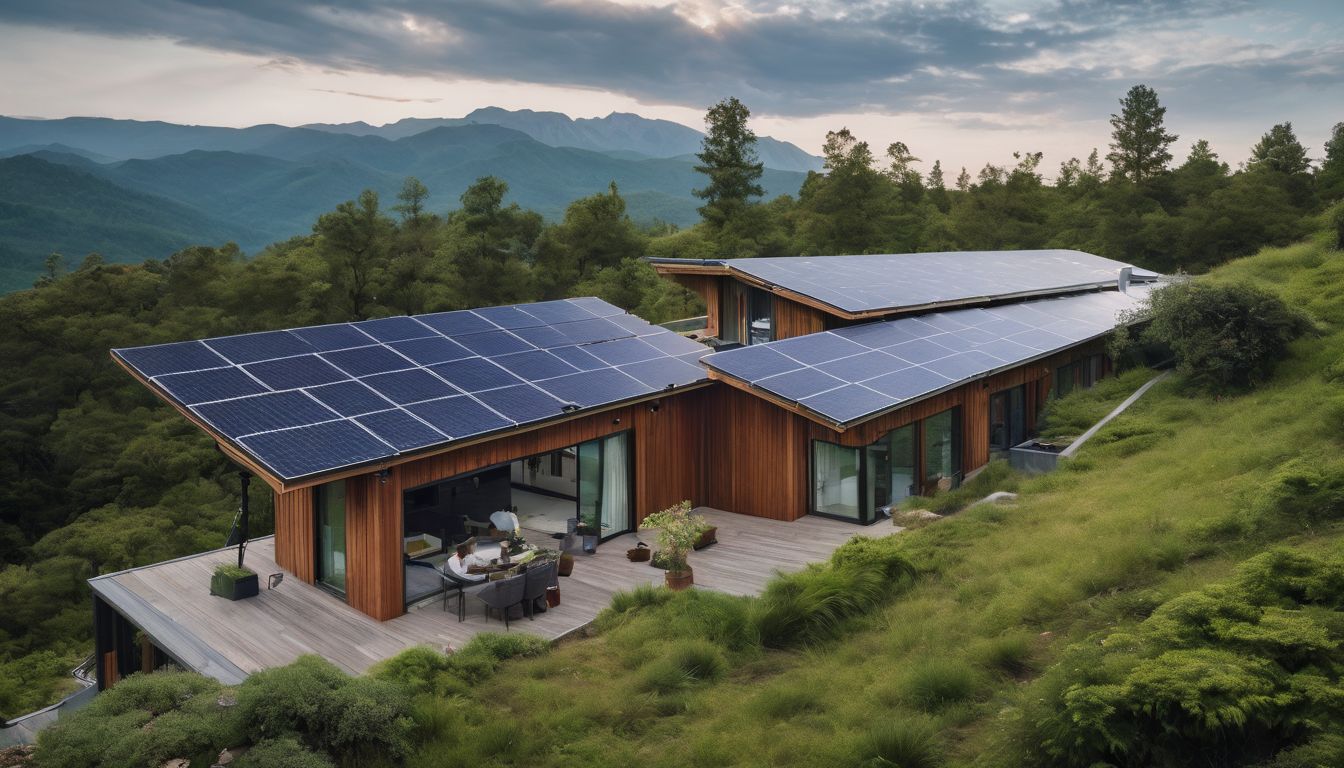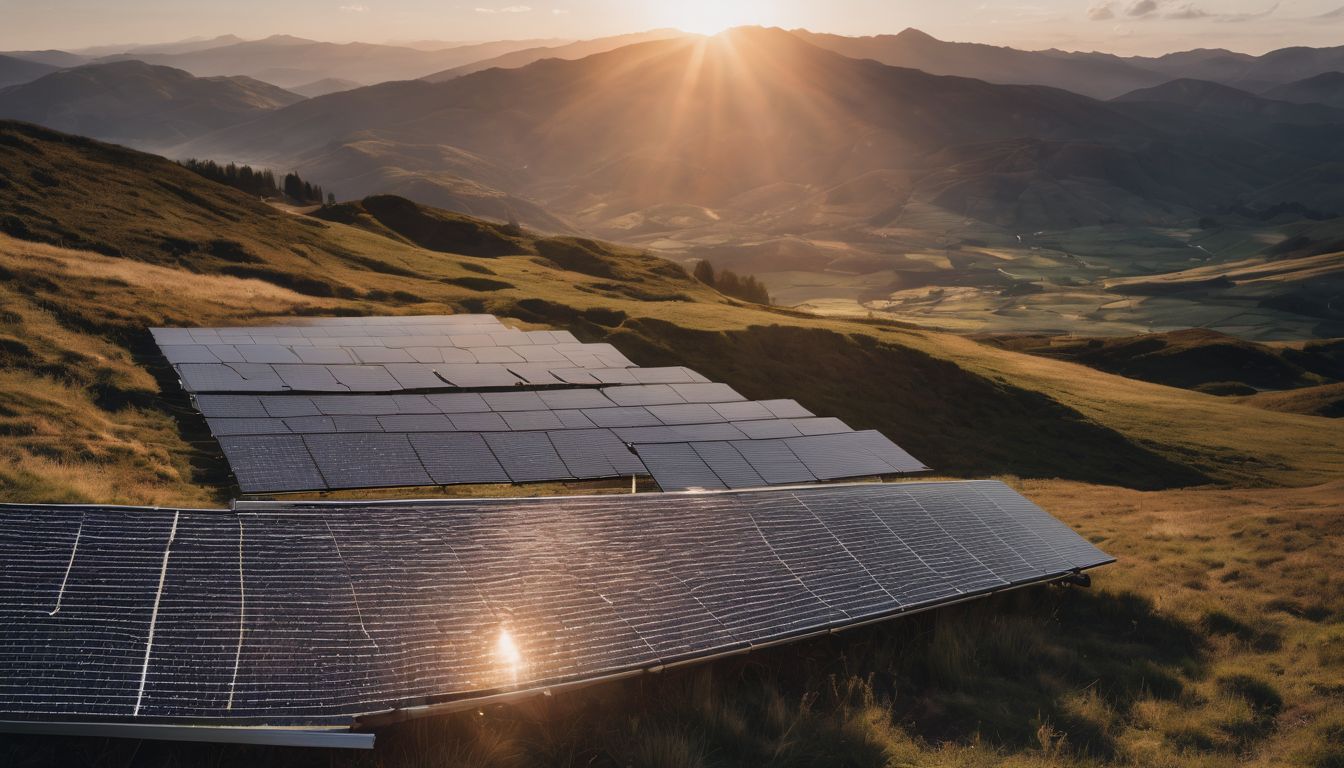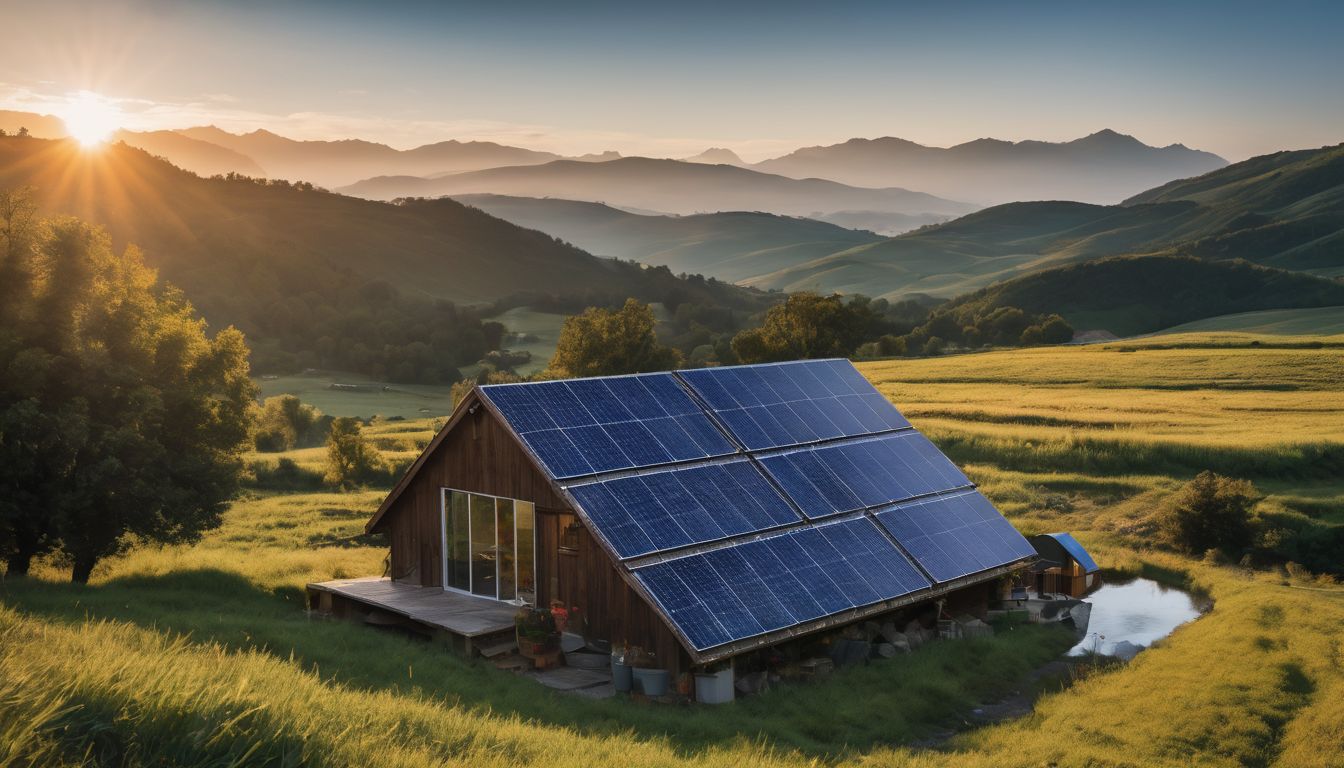Struggling with high energy bills? Solar power is revolutionising how we harness electricity, both in bustling cities and remote countryside. This article explores the stark differences and surprising similarities of solar energy use in urban and rural areas, offering insights for everyone.
Discover a sunnier future ahead!
Key Takeaways
- Urban and rural areas can both benefit greatly from solar energy, with cities using rooftop panels and community solar to reduce emissions and costs, while rural communities gain reliable off-grid power that fosters economic growth.
- Financial barriers, land availability, zoning restrictions, and public perception are key challenges in the adoption of solar energy; however, incentives and educative initiatives can help overcome these obstacles.
- Successful international examples like Germany’s Energiewende policy and China’s investment in solar illustrate how nations can lead in sustainable energy usage by incentivising adoption through favourable policies.
- Solar energy not only lowers carbon footprints but also creates jobs across installation, maintenance, and monitoring sectors—boosting local economies while providing community-wide access to clean power.
- Continued investment and innovation are critical for the future of solar energy to improve technologies, lower costs, increase efficiency, bridge the rural-urban divide and enhance environmental sustainability.
Solar Energy Usage in Urban Areas
Urban areas can benefit from solar energy through reduced energy costs, increased sustainability, and decreased reliance on traditional power sources. Different types of solar installations, such as rooftop solar panels and community solar farms, are being implemented in cities to promote renewable energy usage.
Success stories from other countries also showcase the potential for urban areas to transition towards sustainable energy solutions.
Benefits of converting urban areas to solar energy
Harnessing solar energy in cityscapes slashes greenhouse gas emissions, curbing air pollution and promoting public health. Solar panels on rooftops transform idle space into power plants, reducing the need for fossil-fuelled electricity generation.
These clean energy sources lower energy costs for residents, creating savings that can be redirected into local economies.
Communities see immediate benefits as solar farms generate jobs across installation, maintenance, and monitoring sectors. By switching to renewable energy, urban areas become leaders in climate action while ensuring energy justice by providing all community sectors with access to sustainable power sources.
Plus, distributed generation through community solar allows people to share in the benefits of solar power even if they don’t have their own roofspace.
Types of solar installations in urban areas
Solar installations in urban areas take various forms and serve different purposes. Here are some common types:
- Rooftop solar panels: These are the most popular type of solar installations in urban areas, as they utilise the available space on buildings to generate clean energy.
- Solar canopies: These structures are installed over parking lots or urban outdoor spaces, providing shade while generating renewable energy.
- Building-integrated photovoltaics (BIPV): BIPV systems are integrated directly into the building architecture, such as solar windows or facades, blending seamlessly with the urban landscape.
- Solar farms on brownfield sites: Vacant urban land, especially former industrial areas, can be repurposed for large-scale solar farms to power urban communities.
- Community solar projects: These initiatives allow multiple urban residents or businesses to invest in a shared solar system, typically located in a convenient offsite location.
- Portable solar generators: These compact units provide a flexible and mobile option for powering various devices and equipment within urban environments.
- Solar street lights: Installed in urban public spaces, these lights harness sunlight during the day and illuminate streets at night, reducing reliance on grid electricity.
- Floating solar arrays: Utilising bodies of water within urban areas, these innovative installations generate electricity while also reducing water evaporation and algae growth.
Success stories from other countries
Germany has successfully embraced solar energy, with their Energiewende policy aiming to transition the country to renewable energy sources. By offering favorable feed-in tariffs and various incentives, Germany has seen a significant increase in residential and commercial solar installations.
The success of this policy has made Germany a global leader in solar energy adoption, reducing carbon emissions and creating new green jobs. Similarly, China’s aggressive investment in solar technology has resulted in the world’s largest solar panel production capacity.
Through government support and incentives, China has effectively expanded access to affordable and clean energy for both rural and urban areas.
Taking inspiration from these global success stories can guide other countries on how to overcome challenges related to land availability, financing, public resistance, and policy barriers when implementing solar energy projects nationwide.
Challenges of Implementing Solar Energy in Urban Areas
One of the main challenges in implementing solar energy in urban areas is the availability of land and zoning restrictions, making it difficult to find suitable spaces for solar installations.
Financial barriers also play a significant role, as initial costs can be high, leading to resistance from businesses and homeowners.
Land availability and zoning restrictions
Land availability and zoning restrictions play a crucial role in the implementation of solar energy projects in urban areas. These limitations often hinder the installation of solar panels on rooftops or open spaces, leading to a reduced capacity for harnessing renewable energy.
Zoning regulations can constrain the development of larger utility-scale solar farms within city limits, making it challenging to meet energy demands sustainably. Consequently, it is essential to address these barriers by advocating for flexible zoning ordinances and identifying suitable plots for solar infrastructure to optimise urban solar potential.
To advance solar energy initiatives in urban areas, policymakers and local authorities must work collaboratively to streamline land use regulations and create incentives for installing solar panels on buildings and public spaces.
Financial barriers
Transitioning from the challenges of land availability and zoning restrictions, financial barriers also present a significant obstacle to implementing solar energy in both urban and rural areas.
The upfront costs of installing solar panels can be daunting for many individuals and communities, especially those with limited financial resources. However, it’s important to recognise that while the initial investment may be high, the long-term savings on energy bills make solar energy an economically viable option.
Additionally, various financing options such as rebates, tax incentives, and low-interest loans can help alleviate some of these financial burdens and make solar energy more accessible to a wider range of people.
Public perception and resistance
Transitioning from financial barriers to public perception and resistance, it is crucial to address the concerns and skepticism surrounding solar energy in urban areas. Public awareness and education are key to dispelling misconceptions about the reliability and efficiency of solar power.
By highlighting successful case studies and the tangible benefits of solar energy, such as reduced electricity bills and environmental impact, communities can overcome resistance towards embracing sustainable energy solutions.
Moreover, fostering open dialogue with local residents about their apprehensions can aid in addressing specific concerns related to aesthetics, property values, or perceived disruptions during installation.
Solar Energy in Rural Areas
Impact of solar energy policies on rural communities, advantages of going off-grid, and successful solar energy initiatives in developing countries. Discover how rural areas are benefitting from solar energy advancements!
Impact of solar energy policies on rural communities
Solar energy policies have the potential to transform rural communities by providing affordable and reliable electricity. These policies can bridge energy disparities, leading to economic growth and improved living standards.
By embracing off-grid solar installations, rural areas can overcome challenges related to grid connection and gain access to clean energy, contributing to environmental sustainability and climate resilience.
Rural electrification through solar power opens doors for job creation and empowerment within these communities. It offers an opportunity for education and innovation, creating a path towards bridging the urban-rural energy gap.
Advantages of going off-grid
Going off-grid with solar power offers rural communities the advantage of energy independence. By harnessing the sun’s energy, residents can generate their electricity, reducing dependence on traditional utility companies and avoiding power outages.
This creates a more resilient and reliable energy supply, crucial for remote areas where grid infrastructure may be inadequate or non-existent. Off-grid solar systems also contribute to environmental conservation by reducing reliance on fossil fuels, thereby decreasing carbon emissions and mitigating climate change impacts.
Off-grid living further empowers rural communities by providing access to clean and sustainable energy sources. This fosters economic self-sufficiency through reduced utility bills and stimulates local job creation in the renewable energy sector.
Successful solar energy initiatives in developing countries
Developing countries have made significant strides in implementing successful solar energy initiatives, benefiting communities and the environment. Through innovative policies and programmes, these nations are overcoming energy poverty and contributing to sustainable development.
From the introduction of micro-grid systems in remote villages to large-scale solar farms powering entire regions, developing countries are embracing renewable energy solutions.
These efforts not only provide reliable electricity but also create employment opportunities and promote economic growth within these areas. By harnessing the abundant sunlight for power generation, developing countries are reducing their reliance on traditional fossil fuels while mitigating climate change impacts.
Bridging the Gap: How Solar Energy Policies Can Empower Rural Areas
Solar energy policies can empower rural areas by providing access to affordable and reliable electricity, creating job opportunities and promoting economic growth, as well as contributing to environmental benefits and climate resilience.
Access to affordable and reliable electricity
Affordable and reliable electricity access remains a critical factor in bridging the urban-rural energy gap. Rural areas often grapple with limited grid connectivity, resulting in sporadic power supply.
Implementation of solar energy policies can empower rural communities by providing sustainable and cost-effective electricity solutions. By embracing off-grid solar installations, these regions can overcome the challenges of distance from centralised power sources.
Empowering rural areas with affordable and reliable electricity through solar initiatives supports economic growth, enhances living standards, and accelerates progress towards environmental sustainability.
Job creation and economic growth
Ensuring access to affordable and reliable electricity in rural areas through solar energy initiatives can spur job creation and economic growth. As more off-grid communities gain electricity access, new opportunities for entrepreneurship arise.
Individuals can establish small businesses, such as charging stations or local manufacturing ventures, which stimulate economic activity within their communities. Additionally, the installation and maintenance of solar power systems create employment opportunities, further contributing to local job creation.
Rural electrification through solar projects not only enhances the livelihoods of individuals but also strengthens the overall economy by increasing productivity and enabling broader participation in economic activities.
Environmental benefits and climate resilience
Solar energy offers significant environmental benefits, including reduced greenhouse gas emissions and air pollution. By harnessing solar power, we can decrease our reliance on fossil fuels, thus mitigating the impact of climate change and improving overall air quality.
The adoption of solar energy contributes to climate resilience by diversifying the energy mix, making communities less vulnerable to disruptions caused by extreme weather events or natural disasters.
Furthermore, solar panels do not produce noise pollution or waste products during operation, making them a clean and sustainable option for electricity generation.
The Future of Solar Energy in Both Urban and Rural Areas
The future of solar energy in both urban and rural areas looks promising, with the potential to bridge the gap between the two. Continued investment and innovation, along with education and awareness, will play a crucial role in driving the adoption of solar energy across different communities.
Education and awareness
Education and awareness about solar energy are key to fostering its adoption in both urban and rural areas. By educating communities about the benefits of solar power, individuals can make informed decisions about its implementation.
Awareness campaigns can highlight how solar energy contributes to environmental conservation and climate resilience, demonstrating its importance in reducing carbon footprints for urban development and rural electrification.
Educational initiatives can also empower communities with the knowledge needed to take advantage of government incentives and rebates for installing solar panels. By increasing public understanding of off-grid capabilities and urban planning strategies, more people can see the potential for sustainable energy solutions.
Developing educational programs that cater to different demographics will be crucial in bridging the gap between urban and rural areas in embracing solar energy participation across diverse community settings.
The spread of accurate information on this topic is pivotal for driving support towards future advancements within this field.
Potential for bridging the rural-urban divide
Bridging the rural-urban divide through solar energy policies holds significant promise for equitable development. Access to affordable and reliable electricity in rural areas can enhance livelihoods and economic opportunities, reducing the urban-rural gap.
Job creation from renewable energy projects can stimulate local economies, offering a pathway for sustainable growth and prosperity in underserved communities. Furthermore, prioritising solar power adoption outside urban centres contributes to environmental benefits and climate resilience, creating a more balanced resource distribution across regions.
Empowering rural areas with solar energy initiatives not only addresses access to electricity but also fosters inclusive development while promoting environmental sustainability.
Importance of continued investment and innovation
Investment and innovation in solar energy are crucial for advancing technology, reducing costs, and increasing efficiency. Continued investment fosters research to develop better solar panels, battery storage solutions, and grid integration technologies.
Innovation drives the creation of new business models that make solar energy more accessible to both urban and rural communities. By investing in research and development, we can improve the reliability and performance of solar installations while making them cheaper and easier to install.
Supporting technological advancement through investment also opens up opportunities for job creation in manufacturing, installation, maintenance, and research sectors within the solar industry.
Innovations like smart grids and advanced monitoring systems enhance the stability of renewable energy sources on a large scale by integrating into existing power infrastructure effectively.
Conclusion
In summary, the potential of solar energy in both urban and rural areas is vast. It provides an opportunity for sustainable development and empowers communities to transition towards renewable energy sources.
By addressing challenges such as land availability, financial barriers, and public perception, solar policies can create a more equitable distribution of clean energy. The future holds promise for bridging the rural-urban divide through education, awareness, and continued innovation.
FAQs
1. What’s the difference between solar energy use in urban and rural areas?
In urban areas, space for solar panels might be limited due to buildings being close together, whilst rural areas often have more room which can be ideal for larger solar installations or off-grid systems.
2. Can homes in cities rely on solar energy as much as those in the countryside?
Yes, city homes can use solar energy effectively even with less space by installing rooftop panels or using community solar projects; however, rural homes may benefit more from expansive setups capable of generating surplus power.
3. Why might someone living off-grid choose solar energy?
People living off-grid in rural areas opt for solar energy because it allows them to produce their own electricity independently without relying on utility companies.
4. Is it easier to set up a solar power system in a rural area than an urban one?
Generally, yes – setting up a large-scale solar power system is typically easier in rural areas due to fewer zoning restrictions and more available land compared to the denser environments found in cities.





